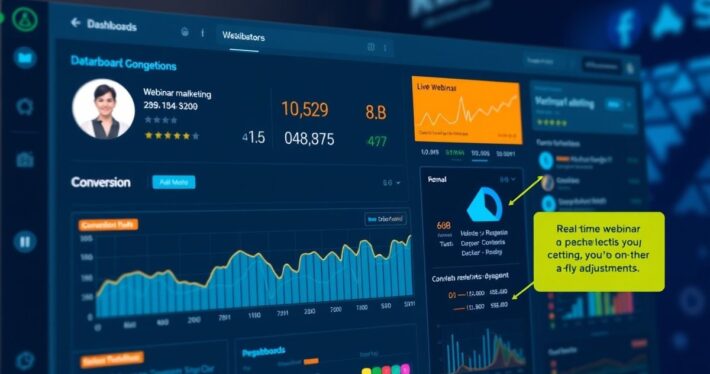Analyzing Registration and Attendance Rates

Maximizing Webinar Success: Analyzing Registration and Attendance Rates
When it comes to webinars, the metrics that matter most are registration and attendance rates. These numbers are the lifeblood of your event’s success, providing critical insights into your audience’s interest and engagement levels. But how do you analyze these rates effectively, and what can you do to improve them? In this comprehensive guide, we’ll dive deep into the strategies and tools that can help you optimize your webinar performance. (Now, here’s the kicker—these are the insights you’ve been waiting for).
Understanding the Basics: Registration vs. Attendance Rates
First things first, let’s break down what these terms mean. Registration rate refers to the number of people who sign up for your webinar, while attendance rate is the percentage of those registrants who actually show up. Sounds simple, right? But there’s more to it than meets the eye.
- Registration rate gives you an idea of how well your marketing efforts are working. Are you reaching the right audience? Is your message compelling enough?
- Attendance rate, on the other hand, tells you how engaging your webinar is. Are people finding value in your content? Are you delivering on the promises made in your marketing materials?
The Importance of Analyzing These Rates
Why should you care about these numbers? Well, let’s be honest—if you’re not measuring, you’re just guessing. Analyzing registration and attendance rates helps you:
- Identify Gaps in Your Marketing Strategy: Low registration rates might indicate that your messaging isn’t resonating with your target audience.
- Gauge Content Effectiveness: High registration but low attendance could mean that your webinar content isn’t living up to expectations.
- Optimize Future Events: By understanding what works and what doesn’t, you can continually improve your webinar strategy.
Key Metrics to Track
To get a comprehensive view of your webinar performance, you’ll need to track several key metrics:
- Total Registrations: The number of people who signed up for your webinar.
- Attendance Rate: The percentage of registrants who attended the webinar.
- Engagement Rate: How active attendees were during the session (e.g., polls, Q&A participation).
- Drop-Off Rate: The percentage of registrants who didn’t attend.
Strategies to Improve Registration Rates
So, how do you increase the number of people signing up for your webinar? Here are some proven strategies:
- Craft Compelling Webinar Titles and Descriptions: Your title should grab attention, and your description should clearly outline the benefits of attending.
- Leverage Multiple Marketing Channels: Use email marketing, social media, and your website to promote your webinar.
- Offer Incentives: Free resources, discounts, or exclusive content can entice people to register.
- Simplify the Registration Process: A complicated form can deter potential registrants. Keep it simple and user-friendly.
Actionable Tips to Boost Attendance Rates
Now that you’ve got people signed up, how do you ensure they show up? Here’s where it gets interesting:
- Send Reminder Emails: A well-timed reminder can make all the difference. Consider sending multiple reminders leading up to the event.
- Create a Sense of Urgency: Highlight the fact that spaces are limited or that exclusive content will be available only during the live session.
- Engage with Registrants Pre-Event: Share teaser content, polls, or surveys to keep them interested and engaged.
- Choose the Right Time and Date: Consider your target audience’s time zone and schedule your webinar at a convenient time.
Real-World Example: A Case Study in Success
Let’s look at a real-world example to tie this all together. Imagine a company, “Tech Innovators,” that recently hosted a webinar on “The Future of AI in Business.” Here’s how they analyzed and improved their registration and attendance rates:
- Problem Identification: Their initial registration rate was decent, but attendance was low.
- Analysis: They discovered that their reminder emails were being sent too early and too often, leading to email fatigue.
- Solution: They optimized their email schedule, sending a reminder one week before the event, one day before, and one hour before.
- Result: Attendance rates increased by 20%, and engagement during the webinar was significantly higher.
Tools to Help You Analyze and Optimize
There are several tools available that can help you track and analyze your webinar performance:
- Webinar Platforms: Most platforms, like Zoom, Webex, and GoToWebinar, offer built-in analytics tools.
- Marketing Automation Tools: HubSpot, Marketo, and ActiveCampaign can help you track registrations and send reminder emails.
- Analytics Tools: Google Analytics and similar tools can provide insights into where your traffic is coming from and how people are interacting with your registration page.
Common Challenges and How to Overcome Them
Even with the best strategies, you might encounter challenges. Here are some common issues and how to tackle them:
- Low Registration Rates: Revisit your marketing materials and ensure they clearly communicate the value of attending.
- High Drop-Off Rates: Simplify your registration process and make sure your reminder emails are engaging and informative.
- Low Engagement During the Webinar: Encourage interaction through polls, Q&A sessions, and real-time chat.
Conclusion: Taking Your Webinars to the Next Level
Analyzing registration and attendance rates is crucial for webinar success. By understanding these metrics and implementing the strategies outlined in this article, you can optimize your webinars for maximum impact. Remember, it’s not just about getting people to register—it’s about creating an engaging experience that keeps them coming back for more.
So, what’s your next step? Start by reviewing your past webinars, identify areas for improvement, and test out these strategies. With the right approach, you’ll be well on your way to hosting webinars that not only attract but also retain a highly engaged audience.



